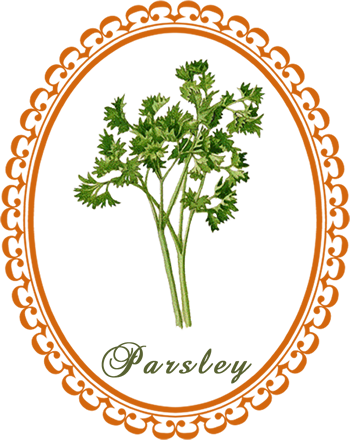
Parsley: is a strong and friendly herb whose virtues go much farther than simply adding flavor to food ...
Common Names: Parsley, Persil, Devil's Oatmeal, Perceley
Botanical Name: Petroselinum crispum
Family: Apiaceae (formerly Umbelliferae)
Plant Type: Hardy biennial
Parts Used: Leaves, roots, and seeds
Parsley is native to the Mediterranean area and Africa.
Description: Parsley is a clump-forming biennial growing to about 30 cm high and twice as wide. It has bright green multi-compound curly or flat leaves. The leaflets are finely divided and held at the end of long stems and the whole plant has a rounded, mound-like shape. In its second summer, parsley sends up stalks with compound umbels of small yellow flowers. There are three types of commonly used parsley: flat leafed or French Parsley (Petroselinum crispum French), normal parsley (Petroselinum crispum) and Hamburg Parsley (Petroselinum crispum var. tuberosum).
Cultivation: Parsley is a hardy biennial. It doesn't transplant well, so sow the seeds where you wish it to grow. Cut the flowers off as they appear the second year or you will have all flower and no leaves.
Companion Plant: Parsley is widely used as a companion plant in gardens. Like many other members of the carrot family (umbellifers), it attracts predatory insects, including wasps and predatory flies to gardens, which then tend to protect plants nearby. For example, they are especially useful for protecting tomato plants as the wasps that kill tomato hornworms also eat nectar from parsley.
Harvesting: The leaves can be harvested at any time during the growing season, and the roots lifted after two years.
Culinary Uses: The finely chopped leaves, fresh or dried, are used to flavor a large variety of dishes, from soups and sauces to fish pies and stews. The leaves are rich in vitamin C, iron, iodine, and magnesium among other nutrients. The roots can be eaten as a vegetable. A sprig of parsley is a familiar garnish on plates in restaurants. Parsley can be chewed to freshen and sweeten the breath and to mask the undesirable smells of tobacco, garlic and onions.
Parsley Magick
Lust. Protection. Purification.
Gender: Masculine
Planet: Mercury
Element: Air
Deity: Persephone
Add parsley to a purification bath.
Eat parsley to provoke lust and promote fertility.
A wreath of parsley worn on the head prevents (or delays) inebriation.
Place a sprig of parsley on your plate to guard your food from contamination.
Herbal Healing with Parsley
Cosmetic Uses: Add parsley infusions to your bathwater to soothe and cleanse.
Medicinal Actions: abortifacient, antianemia, antibacterial, antifungal, antigalactagogue, anti-inflammatory, antilithic, antioxidant, antirheumatic, antiseptic, antispasmodic, aperient, aperitive (in small amounts), aphrodisiac, blood builder, blood purifier, calmative, carminative, cooling, depurative, digestive, diuretic (strong), emmenagogue (strong), estrogenic, expectorant, febrifuge, hepatic, insect repellent, laxative, lithotriptic, parasiticide (intestinal), parturient, purgative, sedative, stimulant (kidneys; uterine contractions), stomachic, tonic (female reproductive and circulatory systems), vasodilator, vermifuge
Medicinal Uses: Parsley is primarily used to aid digestion, stimulate appetite, and correct flatulence and colic. Parsley has a diuretic and tonic effect that assists other herbs such as Pellitory of the Wall (Parietaria), buchu (Barosma), and cornsilk (Zea) that are working on conditions of the kidneys and bladder. Parsley is used to regulate the menstrual cycle; it helps when periods are irregular, and relieves menstrual pain. It tones the uterine muscles and has a stimulating effect on the womb. The juice can be given during childbirth to facilitate contractions.
The chlorophyll in parsley acts as a natural breath freshener. The leaves can be crushed and rubbed on insect bites to relieve itching. The herb has been used to soothe tired or irritated eyes. Fresh leaves can be used as a poultice for sore breasts during lactation. Parsley juice has been used as a hair rinse to be rid of head lice or as a facial steam to heal dry skin. An herbal tea can be used as an enema.
Cautions:
Parsley can cause contractions in large quantities. Most culinary amounts are safe during pregnancy, but it should be avoided in medicinal doses unless given in labor to assist the birth.
The herb oil can cause photosensitivity if ingested.
Large quantities can cause decreased blood pressure and pulse.
It can irritate the kidneys if overused.
Preparation and Dosage:
An infusion can be made by putting 2 ounces of Parsley leaves or root in 2.5 cups of boiling water and let it steep for ten minutes. Strain and drink after the infusion has cooled.
A decoction of the root can be made by placing thin slices of parsley root in 8 ounces of cold water and bringing to a boil. Simmer on low heat for ten minutes. Strain. This can be taken three times per day.
If you appreciate the information provided,
please help keep this website running. Blessings!
© 2008-2025 aromaworx.ca. All rights reserved.

